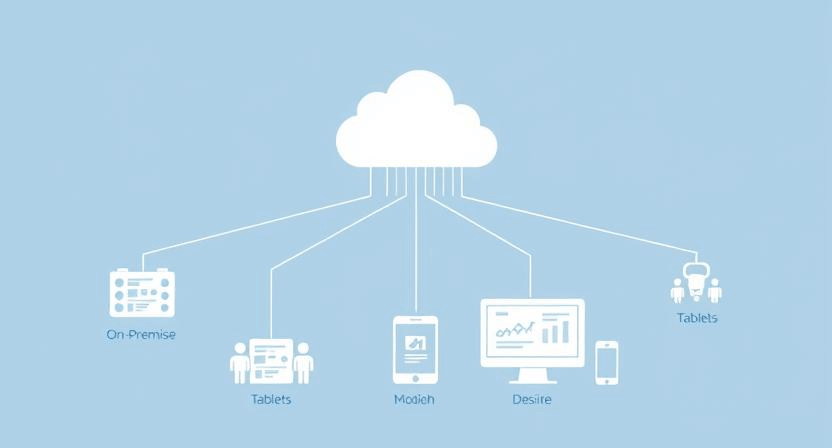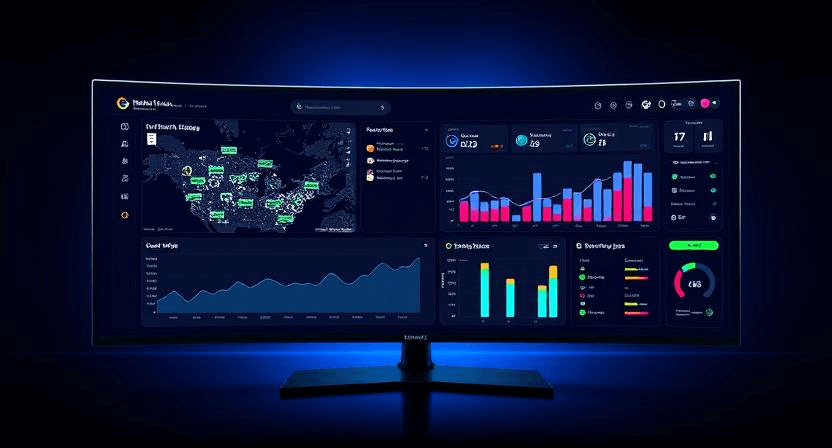In today’s fast-paced business landscape, the demands placed on field service operations are evolving. Organizations must ensure rapid response times, proactive scheduling, and seamless service delivery. Cloud-based solutions for dispatch software are emerging as a game changer in this arena. With the increasing migration from on-premise solutions to cloud-first strategies, companies across industries are leveraging modern technology to optimize their operations.
This blog will explore how cloud dispatch software is revolutionizing field service management (FSM). We will discuss the driving factors behind this shift, the unique advantages of cloud-based field service solutions, and how organizations in various sectors—from HVAC to medical equipment manufacturing—can capitalize on these innovations to streamline their processes.

The Evolution of Dispatch Software
The journey of dispatch software began with manual logs and analog systems that inevitably led to inefficiencies and delays. Over time, technological advancements introduced digital scheduling and dispatching systems that provided better oversight and coordination. However, these earlier systems were often confined to in-house servers, which meant higher upfront costs, limited scalability, and constraints on remote operations.
Today’s landscape is markedly different. The emergence of cloud-based software has broken down many of these barriers. By moving dispatch software to the cloud, companies can overcome the limitations of legacy systems and take advantage of features that directly impact operational efficiency and customer satisfaction.
Why the Shift to Cloud-Based Solutions?
The move toward cloud-based solutions is driven by several factors:
- Flexibility and Accessibility: Cloud dispatch software enables field service managers to access data and manage operations from anywhere, at any time, using any device with an internet connection. This flexibility is especially crucial for industries that rely on rapid response, such as emergency services and HVAC.
- Cost Efficiency: Eliminating the need for expensive on-premise hardware, cloud-based platforms reduce overall IT expenditure. The Software as a Service (SaaS) model allows companies to pay only for what they use, making it an attractive option for businesses of all sizes.
- Scalability: As organizations grow, so does the complexity of their operations. Cloud-based systems are inherently scalable, allowing businesses to expand their capabilities without significant additional investments. This scalability is a hallmark of modern SaaS dispatch solutions and scalable dispatch systems.
- Real-Time Data Integration: Cloud integration FSM enables real-time updates and analytics, helping field operations managers make data-driven decisions and swiftly adapt to changing circumstances.
- Enhanced Collaboration: Cloud solutions often come with collaborative tools that improve communication between dispatchers, technicians, and customers, leading to greater coordination and efficiency.
Key Benefits of Cloud Dispatch Software
The advantages of adopting a cloud-first approach to dispatch software are manifold:
Enhanced Operational Efficiency
Cloud-based dispatch solutions consolidate multiple functionalities into a single, unified platform. This integration enables organizations to manage dispatching, scheduling, customer communications, and inventory tracking in one place. The result is a dramatic reduction in manual tasks and administrative overhead, freeing up teams to focus on high-priority activities.
Improved Data Visibility and Analytics
Access to real-time data is one of the most significant benefits of cloud integration FSM. The ability to view live information about field operations allows managers to quickly identify bottlenecks, track technician performance, and optimize routes. Furthermore, robust analytics dashboards help in forecasting demand and planning resources effectively.
Cost-Effectiveness
Traditional dispatch software often required heavy investment in both hardware and IT support. Cloud-based field service platforms leverage a subscription-based model, substantially reducing capital expenditure. Businesses can select service tiers that best match their needs, ensuring a tailored solution that scales with their operational demands.
Robust Security and Compliance
One common concern when transitioning to cloud-based solutions is security. However, modern cloud dispatch platforms are built with advanced security protocols that ensure data privacy and compliance with international standards. Regular software updates and dedicated cybersecurity measures protect sensitive business data, giving managers confidence in the system’s reliability.
Streamlined Remote Dispatch Management
One of the most compelling features of cloud-based solutions is their support for remote dispatch management. Technicians working offsite, whether in urban centers or remote locations, can receive updates, report issues, and access detailed job instructions in real time. This connectivity fosters quicker response times and increased customer satisfaction, establishing a competitive edge in fast-moving industries.
Unpacking the Technology Behind Cloud Dispatch Software
The transformation from traditional dispatch systems to cloud-based platforms is underpinned by several technological innovations:

SaaS Dispatch Solutions
SaaS models have reshaped software deployment across industries. In the context of dispatch software, the SaaS model allows businesses to use advanced functionalities without the burden of managing underlying infrastructure. SaaS dispatch solutions are continuously updated, providing access to new features and improvements without any downtime or additional cost.
Scalable Dispatch Systems
Scalability is at the core of cloud-based solutions. Whether a company is managing a small team of technicians or a large, geographically dispersed workforce, cloud dispatch systems can grow with the business. The underlying architecture is designed to handle varying workloads efficiently, ensuring optimal performance even during peak periods.
Cloud Integration FSM
Integrating various facets of field service management into one cloud-based platform is a significant technological feat. Cloud integration in FSM bridges the gap between dispatch software, CRM systems, and other operational tools. This seamless data integration facilitates smoother workflows and better decision-making.
Remote Dispatch Management
Cloud dispatch software inherently supports remote operations. In an era where remote work and field mobility are increasingly important, having a system that allows real-time updates irrespective of location is essential. This remote capability means that managers can track job progress, reassign tasks, and communicate with field staff without the geographical limitations of traditional systems.
Industry Applications and Impact
Cloud-based dispatch software is not a one-size-fits-all solution; its adaptability makes it an ideal fit across a wide range of industries:
HVAC and Home Appliances
For companies in the HVAC and home appliances sectors, timely responses to service requests are critical. Cloud dispatch software enables these companies to optimize their scheduling and routing, ensuring that technicians reach customers promptly. Additionally, real-time updates help in managing emergency repairs efficiently.
Medical Equipment Manufacturers
In the medical field, equipment downtime can have serious repercussions. Cloud-based solutions help medical equipment manufacturers monitor service schedules, manage preventive maintenance, and ensure rapid deployment of technicians. This capability not only improves operational efficiency but also enhances patient safety and satisfaction.
Solar Panel Installation Firms
The installation and maintenance of solar panels require coordinated efforts among multiple teams. By adopting cloud dispatch software, solar panel firms can streamline scheduling, track installation progress, and manage maintenance requests seamlessly. This integrated approach is critical in maintaining high service standards and maximizing system uptime.
Expanding to Other Sectors
Beyond the industries mentioned, many other sectors—ranging from logistics to utility services—can benefit from cloud dispatch software. The key lies in leveraging the system’s flexibility to tailor processes according to specific business needs. For instance, manufacturers can integrate their dispatch solutions with inventory and supply chain management systems, ensuring a more connected and efficient operation.
Implementation Considerations for Cloud Dispatch Solutions
Transitioning to cloud-based dispatch software is a strategic move that requires thoughtful planning and execution. Here are some critical considerations to ensure a smooth implementation:

Assessing Current Systems
Before migrating to the cloud, businesses must evaluate their existing dispatch processes and tools. Identifying the pain points and limitations of current systems will help in selecting a cloud solution that addresses these issues effectively. For example, if a company is struggling with delayed communication between field teams, a system with robust remote dispatch management features should be a priority.
Data Migration and Integration
Transitioning from an on-premise system to a cloud platform involves significant data migration. It is essential to plan this transition carefully to avoid data loss or service disruptions. Moreover, for companies that already use other digital tools, ensuring smooth cloud integration FSM is critical. This process often involves collaborating with IT professionals to harmonize various systems and establish reliable data feeds.
Training and Change Management
Introducing any new technology comes with a learning curve. Effective training programs and change management strategies are indispensable for ensuring that teams adapt quickly to the new system. By investing in thorough training, organizations can maximize the benefits of their new cloud dispatch software from day one.
Security and Compliance
With data migration comes the responsibility of ensuring that sensitive operational details remain secure. Evaluate potential vendors based on their security protocols, certification standards, and track record in handling data breaches. It may also be necessary to update internal policies to align with the cloud provider’s security measures.
Cost-Benefit Analysis
While cloud-based solutions often reduce capital expenditure, it is still important to conduct a detailed cost-benefit analysis. Consider factors such as subscription costs, potential savings from improved efficiency, and the long-term ROI of transitioning to a scalable dispatch system. This analysis will help justify the investment to stakeholders ranging from executive leadership to department heads.
Overcoming Challenges in Cloud Adoption
Despite the numerous benefits, transitioning to cloud dispatch software does come with challenges:
- Connectivity Issues: Since cloud-based systems rely on internet connectivity, businesses must ensure reliable network infrastructure. Temporary disruptions can affect service delivery, so redundant networks or backup protocols are essential.
- Vendor Lock-in: Choosing the right vendor is crucial. Evaluate potential software providers carefully to avoid scenarios where switching providers becomes difficult or costly.
- Integration Complexities: For organizations using multiple systems, integrating various platforms into one coherent cloud-based solution requires careful planning and sometimes custom development.
- User Resistance: New technologies can face resistance from teams accustomed to legacy systems. Communicating the benefits clearly and providing hands-on training can mitigate this issue.
By proactively addressing these challenges, organizations can fully leverage the powerful capabilities offered by modern cloud dispatch software.
Future Trends in Cloud-Based Dispatch Technology
As technology continues to evolve, several trends are emerging that will further shape the dispatch software landscape:
Artificial Intelligence and Machine Learning
Advanced AI algorithms are being integrated into cloud-based dispatch systems to predict service demands, optimize routing, and even automate scheduling. Over time, these technologies will contribute to even higher levels of operational efficiency and cost savings.
Enhanced Mobile Integration
With remote dispatch management becoming increasingly critical, the trend towards enhanced mobile functionality will only accelerate. Future cloud-based platforms will likely provide more sophisticated mobile apps that allow for real-time updates, augmented reality support for technicians, and more intuitive user interfaces.
Internet of Things (IoT) Connectivity
IoT is transforming industries by providing real-time data from connected devices. In FSM, IoT integration can offer insights into equipment performance and predict maintenance needs, further enhancing the value proposition of cloud-based solutions.
Increased Customization
As businesses seek tailored solutions, vendors are likely to offer more customizable cloud platforms. This flexibility will allow companies to integrate specialized modules, ensuring that the dispatch system perfectly fits their operational model.
Strategies for Maximizing Cloud Dispatch Software ROI
To fully realize the benefits of migrating to cloud dispatch software, organizations should consider the following strategic approaches:

- Define Clear Objectives:
Determine the key performance indicators (KPIs) that you aim to improve through the adoption of cloud-based systems—be it faster response times, reduced operational costs, or better customer engagement. - Engage Stakeholders Early:
Involve decision-makers from different levels—from the CEO and operations managers to field technicians—early in the planning and implementation process. Their input can be invaluable in shaping a system that meets real-world needs. - Invest in Training and Support:
Continual training and technical support are paramount to ensure that the workforce is proficient with the new system. Consider investing in vendor training sessions, online tutorials, and real-time customer support. - Monitor, Measure, and Adjust:
Utilize the analytics capabilities inherent in cloud-based platforms to track performance. Regularly review your KPIs and adjust processes as needed to continuously improve the efficiency of your dispatch operations. - Plan for Future Growth:
A key advantage of cloud dispatch software is its scalability. As your business grows, ensure that your system can be upgraded or expanded seamlessly, maintaining a competitive edge in a dynamic market environment.
The shift towards cloud dispatch software marks a monumental turning point in the field service management landscape. With benefits ranging from enhanced data visibility and improved operational efficiency to robust scalability and cost savings, cloud-based solutions address the growing demands of modern service operations. Whether your business is rooted in HVAC, home appliances, medical equipment, or solar panel installation, transitioning to a cloud-based field service platform can unlock tremendous potential.
By harnessing the advantages of SaaS dispatch solutions, scalable dispatch systems, remote dispatch management, and comprehensive cloud integration FSM, companies can better serve their customers while optimizing internal processes. The future of dispatch technology is undoubtedly cloud-based, and those who embrace it today will be well-positioned to lead in tomorrow’s competitive marketplace.
As industries continue to evolve, leveraging technology to drive better outcomes is essential. Organizations that invest in modern cloud-based solutions not only gain operational agility but also secure a strategic advantage in a constantly changing environment. Ultimately, the journey toward a fully integrated, cloud-enabled field service management system is not just a technological upgrade—it’s a transformative shift that can propel your business to new heights.
By making this change, you not only optimize your dispatch processes but also pave the way for innovative practices, increased customer satisfaction, and sustainable growth in an increasingly digital world. Embrace the future with cloud-based dispatch software and unlock unparalleled potential for your business.
Book a demo Free today and see how Fieldax can revolutionize your dispatch process.
Author Bio

Palani Kumar
Palani Kumar is a seasoned digital marketing professional with over 13 years of experience in crafting impactful strategies for B2B brands.
As the marketing lead at FieldAx, he focuses on bridging the gap between technology and business growth, simplifying complex field service management concepts into valuable insights.
Passionate about delivering informative and practical content, Palani writes about industry trends, best practices, and innovations that help businesses optimize their field operations.
When not working on marketing strategies, he enjoys exploring history, engaging in thought-provoking discussions, and appreciating the balance between technology and tradition.





